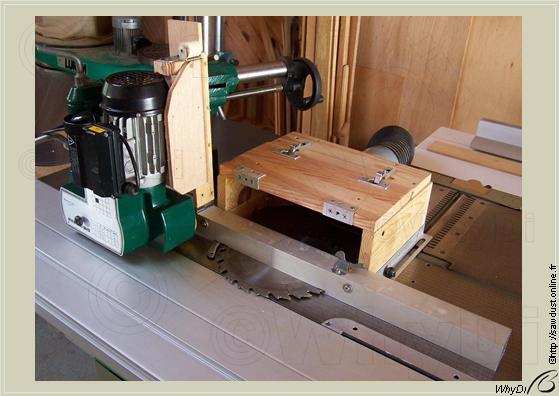Resawing Into Veneer, up to 75mm (3")
Now I was able to resaw on the table saw I spent much time thinking about a safe way of turning thin board into veneer and came up with the idea that the spindle moulder might meet my wish. The motor had enough torque and a sharp saw blade would probably work as well it would on the table saw. On the other hand saw arbour diameter equalled spindle moulder shaft diameter and after some tests I retained a blade with few teeth that easily channelled dust and demanded less power which mainly meant less v-belt friction on the pulley.
Although a 300mm (12") blade in diameter could be locked on the spindle moulder shaft and a 250 (10") one had the ability of digging deeper, I took to cutting up to 75mm (3") which meant two passes allowed 150 mm (6").
Although a 300mm (12") blade in diameter could be locked on the spindle moulder shaft and a 250 (10") one had the ability of digging deeper, I took to cutting up to 75mm (3") which meant two passes allowed 150 mm (6").

Here the splitter did not aim safety because thin wood sheets had not the ability to pinch the blade causing a kickback. It was closely related to the power feeder work and prevented the rear teeth from damaging the wood. The below drawing shows how.
Please note the power feed unit solely allowed a steady feed and I didn't reach satisfying results by hand. Besides I never felt comfortable hand feeding the workpiece through that horizontal saw blade, in spite of the guard fully covered the working tool and the use of a push stick in the right hand and a push block in the left one.
Please note the power feed unit solely allowed a steady feed and I didn't reach satisfying results by hand. Besides I never felt comfortable hand feeding the workpiece through that horizontal saw blade, in spite of the guard fully covered the working tool and the use of a push stick in the right hand and a push block in the left one.

So I typically resaw flat, straight and square boards 6.5 mm thick, up to 150 mm wide and at least 600 mm in length (0.25x6x24 inches). After setting and adjusting the shop made tool housing, the veneer fence and the power feed unit, the workpiece starts going through the blade by hand until the power feeder get the front piece and keep going about four meters per minute (13 feet per minute). From there I just have to maintain the workpiece with a suitable sacrificed push block until the back side reaches the blade then flip the stock left to right and make the second cut, if needed.

